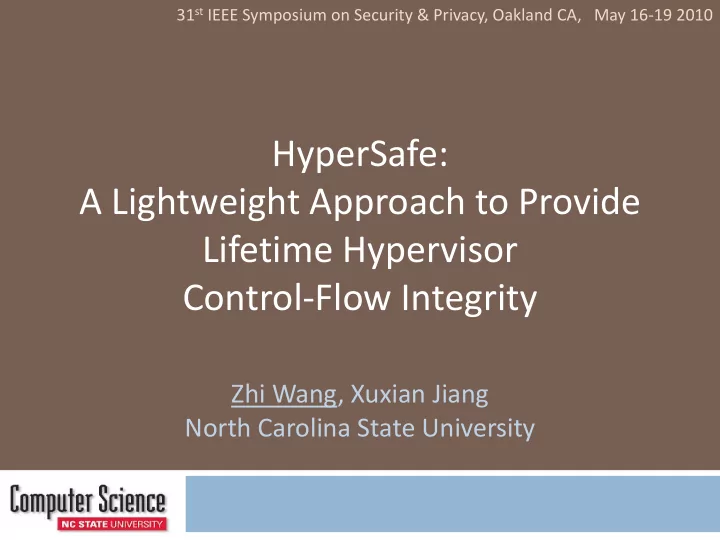

31 st IEEE Symposium on Security & Privacy, Oakland CA, May 16-19 2010 HyperSafe: A Lightweight Approach to Provide Lifetime Hypervisor Control-Flow Integrity Zhi Wang, Xuxian Jiang North Carolina State University
Outline Motivation Design Implementation & Evaluation Related Work Summary
Outline Motivation Design Implementation & Evaluation Related Work Summary
Virtualization Adoption Rapidly growing in industry 16% server workloads on virtual machines now 50% by 2012 1 Widely applied to security problems Guest integrity monitoring ReVirt (Dunlap et al, OSDI ‘02), Livewire ( Garfinkel et al, NDSS ‘03), VMwatcher (Jiang et al, CCS ‘07), Lares (Payne et al, Oakland ‘08), SIM (Sharif et al, CCS ’09)… Guest integrity protection SecVisor (Seshadri et al, SOSP ‘07), NICKLE (Riley et al, RAID ‘08), HookSafe (Wang et al, CCS ‘09)… System software analysis AfterSight (Chow et al, USENIX ATC ’08), K -Tracer (Lanzi et al, NDSS ‘09), PoKeR (Riley et al, EuroSys ‘09) … … 1 :Gartner Symposium/ITxpo 2009
Common Assumption A Trustworthy Hypervisor!
Bloated TCB of Type I Hypervisors Hypervisor Hypervisor SLOC TCB Xen-4.0 194K Xen, Dom0 VMware ESXi 1 200K VM Kernel Hyper-V 1 100K Hyper-V, Windows 2008 Server BitVisor 194K BitVisor 1. NOVA: A Microhypervisor-Based Secure Virtualization Architecture (Udo Steinberg et al, EuroSys ‘10)
Vulnerabilities & Attacks Common Vulnerabilities and Exposures (CVE) Xen - 26, VMware ESX - 18 (til 11/2009) VM escape attacks Xen 0wning Trilogy (Invisible Things Lab, Blackhat ‘08) Cloudburst: A VMware Guest to Host Escape (Kostya Kortchinsky, Blackhat ‘09) Hypervisor based rootkits SubVirt (King et al, Oakland ‘06), Blue Pill (Invisible Things Lab, Blackhat ‘06), Virtiol (Dino A. Dai Zovi, Blackhat ‘06)
Existing Solutions Reduce TCB TrustVisor (McCune et al, Oakland ‘10), NOVA (Steinberg et al, EuroSys ‘10) , Improving Xen Security through Disaggregation (Murray et al, VEE ‘08), … Formal verification seL4 (Klein et al, SOSP ‘09), … Our goal is to enable self-protection of commodity type-I (bare-metal) hypervisors!
Outline Motivation Design Implementation & Evaluation Related Work Summary
Assumptions Trustworthy (x86) hardware IOMMU to prevent malicious DMA transactions Trusted System Management Mode (SMM) Software bugs in the hypervisor
Our Approach: HyperSafe trusted booting load-time (e.g. tboot) integrity lifetime non-bypassable code integrity hypervisor CFI memory lockdown runtime CFI control data integrity restricted pointer indexing
Non-bypassable Memory Lockdown
x86 Paging Mode Page tables determine memory properties Permissions in a page table entry: NX – Non-executable N R U R/W – Read-only or Writable X W S N R U U/S – User or supervisor page X W S W X: a page can be either writable … N R U or executable, but not both X W S All memory accesses by software are translated and controlled by page tables Including reads/writes of page tables
HyperSafe’s Memory Lockdown Pitfalls in existing W X Mixed code and data Mixed code and data are prohibited Double mapping with conflicting attributes Double mapping must have conforming attributes Writable page tables Read-only page tables No code can modify the write-protected hypervisor code and data!
Challenge How to safely allow benign page table updates???
Hardware Feature to the Rescue! Write-protect (WP) bit in CR0 controls interaction of supervisor and read-only pages WP = 1: Read-only pages are protected even from supervisor WP = 0: Supervisor can write into read-only pages
Benign Page Table Updates WP = 1 by default to lock down memory Update page table atomically Disable interrupt 1. Read-only Page Tables WP = 0 2. WP WP Verify proposed change 3. off on Update read-only page table 4. WP = 1 5. Enable interrupt 6.
Restricted Pointer Indexing (RPI)
Control Flow Integrity (CFI) CFI: runtime execution paths must follow control flow graph (CFG) CFG may have different granularities Indirect call may go to: All indirectly Functions with Points-to set called functions same type Coarse-grained Fine-grained
CFG Construction in HyperSafe Points-to analysis required Manual analysis to handle domain knowledge / assembly code in prototype e.g. assembly code to access per-cpu data (function pointers) in gs segments
Enforce Control Flow Integrity Restricted Pointer Indexing Collect control data into tables (protected by memory lockdown) Replace control data with the indexes to the table Convert the index back to transfer control Only legitimate control data in the table can be used for control flow transfer!
Outline Motivation Design Implementation & Evaluation Related Work Summary
Implementation Implementing techniques: Memory lockdown: modify hypervisor’s memory management code Restricted Pointer Indexing: extend LLVM compiler to instrument related instructions Prototypes of HyperSafe: Full support for BitVisor Partial support for Xen, additional engineering needed
Security Analysis Disable WP bit Misuse page table update function RPI Subvert page table Misuse page table update function RPI Map hypervisor memory to a compromised guest VM Memory lockdown Return-oriented programming Memory lockdown, RPI
Performance: Applications Normalized Application Overhead Compared to Original BitVisor HS-2 HS-m 6% 5% 1% 1% 1% 0% Decompress Kernel Build ApacheBench HS-2 implements coarse-grained RPI with two target tables (return instructions and indirect calls) HS-m implements fine-grained RPI with one target table per function and indirect call
Performance: LMbench Normalized LMbench Overhead Compared to Original BitVisor HS-2 HS-m 5.5% 5.4% 4.5% 3.5% 3.4% 2.8% 1.2% 0.6% 0.0% 0.6% ctx stat mmap sh proc 10K file bcopy -2.2% -2.4%
Related Work Program Analysis and Formal Proof seL4 (Klein et al, SOSP ‘09), WIT ( Akritidis et al, SOSP ‘08), KLEE (Cadar et al, OSDI ‘08), … Guest Integrity Monitoring or Protection SIM (Sharif et al, CCS ‘09), SecVisor (Seshadri et al, SOSP ‘07), SBCFI (Petroni et al, CCS ‘07), … Trusted Computing TrustVisor (McCune et al, Oakland ‘10), Flicker (McCune et al, EuroSys ‘08), Pioneer ( Seshadri et al, SOSP ’05), …
Summary HyperSafe is a lightweight approach to provide lifetime control-flow integrity for commodity Type- I hypervisors. load-time trusted booting integrity (e.g. tboot) lifetime non-bypassable code integrity hypervisor CFI memory lockdown runtime CFI control data integrity restricted pointer indexing
Thanks, Questions?
Recommend
More recommend